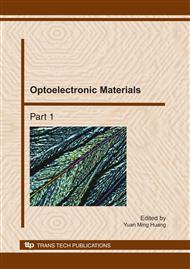[1]
D. Bersani, G. Antonioli, P. P. Lottici, Y. Dimitriev, V. Dimitrov and P. Kobourova: Non-Cryst. Solids. Vol. 232 (1998), p.293.
DOI: 10.1016/s0022-3093(98)00494-3
Google Scholar
[2]
A.A. El-Moneim: Mater. Chem. Phys. Vol. 73, (2002), p.318.
Google Scholar
[3]
F.M. Ezz-Eldin: Nucl. Instrum. Meth. B. Vol. 1599, (1999), p.166.
Google Scholar
[4]
S. Mandal, S. Hazra, D. Das and A. Ghosh: Non-Cryst. Solids Vol. 183, (1995), p.315.
Google Scholar
[5]
V. Dimitrov: Non-Cryst. Solids, Vol. 192 (1995), p.183.
Google Scholar
[6]
J.M. Lewis, C.P. OBrien, M. Affatigato and S.A. Feller: Non-Cryst. Solids Vol. 293 (2001), p.663.
Google Scholar
[7]
K.V. Ramesh and D.L. Sastry: Physica B. Vol. 387 (2007), p.45.
Google Scholar
[8]
E. Mansour, Y.M. Moustafa, G.M. EI-Damrawi, S. Abd EI-Maksoud and H. Doweidar: Physica B. Vol. 305 (2001), p.242.
DOI: 10.1016/s0921-4526(01)00622-6
Google Scholar
[9]
S. Chakraborty, M. Sadhukhan, B.K. Chaudhuri, H. Mori and H. Sakata: Mater. Chem. Phys. Vol. 50 (1997), p.219.
Google Scholar
[10]
S. Sen and A. Ghosh: Non-Cryst. Solids Vol. 258 (1999), p.29.
Google Scholar
[11]
G.D. Khattak and N. Tabet: Electron Spectrosc. Relat. Phenom. Vol. 136 (2004), p.257.
Google Scholar
[12]
M.S. Aziz, F. Abdel-Wahab, A.G. Mostafa and E.M. EI-Agwany: Mater. Chem. Phys. Vol. 91 (2005), p.532.
Google Scholar
[13]
P. Machowski, M. Opallo, J.E. Garbarczyk and M. Wasiucionek: Solid State Ionics Vol. 157 (2003), p.287.
Google Scholar
[14]
N. Tashtoush, A.M. Qudah and M.M. El-Desoky: Non-Cryst. Solids Vol. 68 (2007), p. (1926).
Google Scholar
[15]
V. Rajendran, N. Palanivelu, B.K. Chaudhuri and K. Goswami: Non-Cryst. Solids Vol. 320 (2003), p.195.
Google Scholar
[16]
V. Dimitrov, Y. Dimitriev and A. Montenero: Non-Cryst. Solids Vol. 180 (1994), p.51.
Google Scholar
[17]
C.N. Reddy, V.C. Veeranna Gowda and R.P. Sreekanth Chakradhar: Non-Cryst. Solids Vol. 354 (2008), p.32.
Google Scholar
[18]
M.M. EI-Desoky and M.S. AI-Assiri: Mater. Sci. Eng. B. Vol. 137 (2007), p.237.
Google Scholar
[19]
S.A. Ketkar, G.G. Umarji, G.J. Phatak, J.D. Ambekar, I.C. Rao, U.P. Mulik and D. P. Amalnerkar: Mater. Sci. Eng. B. Vol. 132 (2006), p.215.
DOI: 10.1016/j.mseb.2006.02.027
Google Scholar
[20]
J. -Y. Song and S. -Y. Choi: Displays Vol. 27 (2006), p.112.
Google Scholar
[21]
R. Morena: J. Non-Cryst. Solids Vol. 263 (2000), p.382.
Google Scholar
[22]
China Industry Standard of SJ3232. 3, (1989).
Google Scholar
[23]
Y. Dimitriv, V. Dimitrov, M. Arnaudov and D. Topalov: J. Non-Cryst. Solids Vol. 57 (1983), p.147.
Google Scholar


